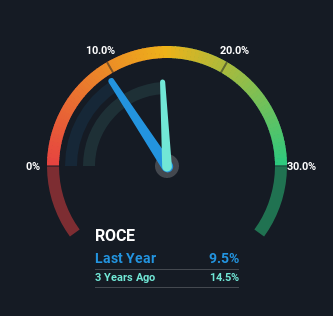- India
- /
- Auto Components
- /
- NSEI:JAYBARMARU
Jay Bharat Maruti (NSE:JAYBARMARU) Might Be Having Difficulty Using Its Capital Effectively

Did you know there are some financial metrics that can provide clues of a potential multi-bagger? Amongst other things, we'll want to see two things; firstly, a growing return on capital employed (ROCE) and secondly, an expansion in the company's amount of capital employed. Put simply, these types of businesses are compounding machines, meaning they are continually reinvesting their earnings at ever-higher rates of return. Although, when we looked at Jay Bharat Maruti (NSE:JAYBARMARU), it didn't seem to tick all of these boxes.
What is Return On Capital Employed (ROCE)?
If you haven't worked with ROCE before, it measures the 'return' (pre-tax profit) a company generates from capital employed in its business. The formula for this calculation on Jay Bharat Maruti is:
Return on Capital Employed = Earnings Before Interest and Tax (EBIT) ÷ (Total Assets - Current Liabilities)
0.095 = ₹749m ÷ (₹13b - ₹5.4b) (Based on the trailing twelve months to March 2022).
Thus, Jay Bharat Maruti has an ROCE of 9.5%. On its own, that's a low figure but it's around the 11% average generated by the Auto Components industry.
View our latest analysis for Jay Bharat Maruti

Historical performance is a great place to start when researching a stock so above you can see the gauge for Jay Bharat Maruti's ROCE against it's prior returns. If you'd like to look at how Jay Bharat Maruti has performed in the past in other metrics, you can view this free graph of past earnings, revenue and cash flow.
What The Trend Of ROCE Can Tell Us
When we looked at the ROCE trend at Jay Bharat Maruti, we didn't gain much confidence. Around five years ago the returns on capital were 20%, but since then they've fallen to 9.5%. Although, given both revenue and the amount of assets employed in the business have increased, it could suggest the company is investing in growth, and the extra capital has led to a short-term reduction in ROCE. If these investments prove successful, this can bode very well for long term stock performance.
On a side note, Jay Bharat Maruti's current liabilities are still rather high at 40% of total assets. This effectively means that suppliers (or short-term creditors) are funding a large portion of the business, so just be aware that this can introduce some elements of risk. Ideally we'd like to see this reduce as that would mean fewer obligations bearing risks.
Our Take On Jay Bharat Maruti's ROCE
In summary, despite lower returns in the short term, we're encouraged to see that Jay Bharat Maruti is reinvesting for growth and has higher sales as a result. And there could be an opportunity here if other metrics look good too, because the stock has declined 54% in the last five years. So we think it'd be worthwhile to look further into this stock given the trends look encouraging.
On a final note, we found 4 warning signs for Jay Bharat Maruti (2 make us uncomfortable) you should be aware of.
While Jay Bharat Maruti isn't earning the highest return, check out this free list of companies that are earning high returns on equity with solid balance sheets.
If you're looking to trade Jay Bharat Maruti, open an account with the lowest-cost platform trusted by professionals, Interactive Brokers.
With clients in over 200 countries and territories, and access to 160 markets, IBKR lets you trade stocks, options, futures, forex, bonds and funds from a single integrated account.
Enjoy no hidden fees, no account minimums, and FX conversion rates as low as 0.03%, far better than what most brokers offer.
Sponsored ContentNew: Manage All Your Stock Portfolios in One Place
We've created the ultimate portfolio companion for stock investors, and it's free.
• Connect an unlimited number of Portfolios and see your total in one currency
• Be alerted to new Warning Signs or Risks via email or mobile
• Track the Fair Value of your stocks
Have feedback on this article? Concerned about the content? Get in touch with us directly. Alternatively, email editorial-team (at) simplywallst.com.
This article by Simply Wall St is general in nature. We provide commentary based on historical data and analyst forecasts only using an unbiased methodology and our articles are not intended to be financial advice. It does not constitute a recommendation to buy or sell any stock, and does not take account of your objectives, or your financial situation. We aim to bring you long-term focused analysis driven by fundamental data. Note that our analysis may not factor in the latest price-sensitive company announcements or qualitative material. Simply Wall St has no position in any stocks mentioned.
About NSEI:JAYBARMARU
Jay Bharat Maruti
Manufactures and sells auto components and assembly systems in India.
Slight second-rate dividend payer.
Similar Companies
Market Insights
Community Narratives



